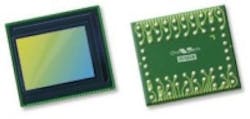OmniVision and Silicon Line collaboration brings high-speed image and video data to new applications
OmniVision Technologies, Inc. and Silicon Line have announced a collaboration to bring high-speed image and video data transfer technology to applications that are noise sensitive and that require longer, thinner, and lighter cables.
MORE ARTICLES
OmniVision officially acquired by consortium of investment firms
CMOS image sensor market could reach $16 billion by 2020
OmniVision introduces compact global shutter camera for mobile and wearable devices
The collaboration will focus on enabling high-speed video transfer for OmniVision's OV5693 CameraChip sensor. The OV5693 is a 1/4” 5 MPixel colorCMOS image sensor that achieves frame rates of 30 fps at full 1080p HD video. Additionally, the sensor features with electronic image stabilization and 720p HD video at 60 fps, and supports a 2-lane MIPI interface with data transfer of up to 1 Gbps per lane. In addition to this sensor, the project will focus on MIPI D-PHY 1.1, 1.2, 2.0 and MIPI C-PHY-based imaging solutions.
Silicon Line, a provider of ultra-low power optical link technology, provides a technology that will benefit a number of different applications, according to Tehzeeb Gunja, senior marketing and business development manager at OmniVision.
“We believe that Silicon Line's approach to high-speed data transfer, and the inherent benefits that its optical link technology brings to our mutual target markets, can help overcome many technical challenges faced by product engineers today," said Gunja. "The ability to affordably and power-efficiently transfer large amounts of uncompressed video data over long distances carries a tremendous potential for positive impact on a number of application areas."
With OmniVision extending its portfolio with higher resolution and higher frame rate image sensors, the required data rate for image transfer increases dramatically, said Ian Jackson, senior manager sales and marketing at Silicon Line.
"A single optical fiber can transport up to 25 Gbps of data. This has obvious benefits in terms of size and weight reductions, enabling smaller and lighter industrial designs for space-constrained applications like tablets and notebooks,” he said.
He continued, “Another benefit of optical fiber is zero susceptibility to electromagnetic interference, which enables a noise free picture. Lastly, optical technology can transport high-speed image data over many meters whereas a traditional electrical connection is limited to 10 or 20 cm, making optical technology well-suited for applications such as automotive,medical and security imaging systems.”
View more information onOmniVision.
View more information on Silicon Line.
Share your vision-related news by contactingJames Carroll, Senior Web Editor, Vision Systems Design
To receive news like this in your inbox,click here.
Join ourLinkedIn group | Like us on Facebook | Follow us on Twitter| Check us out on Google +
This article was originally published on 5/19/2015
About the Author

James Carroll
Former VSD Editor James Carroll joined the team 2013. Carroll covered machine vision and imaging from numerous angles, including application stories, industry news, market updates, and new products. In addition to writing and editing articles, Carroll managed the Innovators Awards program and webcasts.
